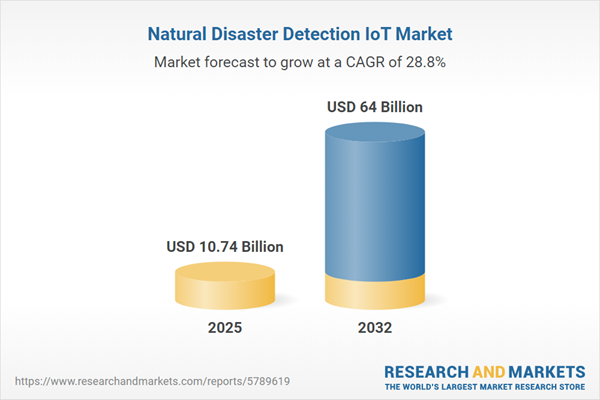Speak directly to the analyst to clarify any post sales queries you may have.
The Natural Disaster Detection IoT Market is experiencing rapid evolution as organizations worldwide prioritize advanced early-warning and risk resilience systems. Senior decision-makers are increasingly leveraging integrated IoT architectures to achieve comprehensive, real-time insights across sectors such as infrastructure, energy, and agriculture.
Market Snapshot: Natural Disaster Detection IoT Market Growth and Dynamics
The Natural Disaster Detection IoT Market grew from USD 8.45 billion in 2024 to USD 10.74 billion in 2025. It is projected to maintain a CAGR of 28.78% through 2032, reaching a value of USD 64.00 billion. This robust trajectory reflects surging investments in edge computing, sensor networks, data analytics, and collaborative technologies, underscoring heightened demand for advanced disaster preparedness and operational continuity. Technology convergence and cross-sector partnerships drive market expansion across global regions.
Scope & Segmentation: Strategic Overview of the Disaster Detection IoT Landscape
The report provides comprehensive segmentation, enabling targeted strategies and investment roadmaps:
- Component: Hardware—including computational and storage devices, data transmission devices, power supply and energy storage, sensors and detectors, user interface and notification systems. Software—including communication and networking software, data analysis and management, geographic information system (GIS) software. Services complete the offering landscape.
- Technology: Advanced computing and big data analytics, artificial intelligence and machine learning, and mobile and communication technologies are central to performance breakthroughs and solution scalability.
- Application: Solutions support drought detection and management, earthquake management, flood and landslide monitoring, forest fire management, and comprehensive weather tracking. This breadth addresses evolving risk environments and regional hazard profiles.
- End-User: Government organizations, law enforcement agencies, private companies, and rescue personnel each require tailored feature sets and interoperability standards for critical scenarios.
- Regional Coverage: Americas (including North and Latin America), Europe, Middle East & Africa, and Asia-Pacific, with further country-level granularity ensuring actionable intelligence for navigating diverse regulatory and climatic conditions.
- Leading Companies Tracked: ABB Ltd., Accenture PLC, Cisco Systems Inc., Environmental Systems Research Institute, Inc (Esri), Google LLC by Alphabet Inc., Hitachi Ltd., Intel Corporation, Nokia Corporation, SAP SE, Sony Group Corporation, Zebra Technologies Corporation, and additional key market participants.
Key Takeaways: Strategic Insights for Decision-Makers
- Edge analytics and integration of machine learning enhance situational awareness, empower timely interventions, and boost confidence in forecasting models.
- Connectivity advances such as 5G and LPWAN allow reliable sensor coverage in remote and challenging environments, closing historical monitoring gaps.
- Sustainability considerations are shaping product design, with emerging emphasis on renewable power supplies and energy harvesting for autonomous operations.
- Cross-sector collaboration—spanning government, private sector, research institutions, and NGOs—accelerates innovation and drives interoperability standards.
- Solution versatility supports a range of hazards; system adaptability to regional climate and regulatory variability remains a crucial deployment factor.
- Data-driven platforms improve asset protection, risk assessment, and continuity planning, enhancing value propositions in critical infrastructure markets.
Tariff Impact: U.S. 2025 Measures Transforming Supply Chain and Sourcing Strategy
Recent U.S. tariffs on semiconductors and sensor modules have elevated procurement costs, driving many manufacturers to diversify supply sources and strengthen regional partnerships. System integrators increasingly pursue local production and compliance-focused procurement, enhancing resilience against trade fluctuations and extended lead times. This shift amplifies the importance of supply chain visibility, vendor diversification, and inventory management within IoT disaster detection ecosystems.
Methodology & Data Sources: Robust, Multi-Layered Analysis
This report utilizes primary research through structured interviews with hardware manufacturers, emergency response leaders, and regulatory experts, alongside systematic secondary analysis of industry reports, patents, and technical standards. Data triangulation and scenario modelling fortify analytical rigor, providing decision-makers with a reliable foundation for strategic planning in the Natural Disaster Detection IoT Market.
Natural Disaster Detection IoT Market: Why This Report Matters
- Enables leaders to benchmark technology readiness, supplier networks, and operational risk posture for continuous improvement.
- Equips organizations with regional and segment insights—supporting tailored strategy development and agile market entry or expansion.
- Identifies emerging opportunities from new connectivity, analytics, and sustainability trends, guiding informed investments in disaster resilience technology.
Conclusion
As IoT-driven systems transform natural disaster detection, collaborative frameworks and agile strategies position organizations to enhance resilience and safeguard critical assets. Informed adoption of these solutions empowers future-proofing against environmental and market uncertainties.
Additional Product Information:
- Purchase of this report includes 1 year online access with quarterly updates.
- This report can be updated on request. Please contact our Customer Experience team using the Ask a Question widget on our website.
Table of Contents
3. Executive Summary
4. Market Overview
7. Cumulative Impact of Artificial Intelligence 2025
Companies Mentioned
The companies profiled in this Natural Disaster Detection IoT market report include:- ABB Ltd.
- Accenture PLC
- ALE International SAS
- Aplicaciones Tecnológicas S.A.
- AT&T Inc.
- Atos SE
- BlackBerry Limited
- Cisco Systems Inc.
- Eaton Corporation PLC
- Environmental Systems Research Institute, Inc
- Google LLC by Alphabet Inc.
- Green Stream Technologies, Inc.
- Grillo Holdings Inc.
- Hala Systems, Inc.
- Hitachi Ltd.
- InfiSIM Ltd.
- Infosys Limited
- Intel Corporation
- International Business Machines Corporation
- Knowx Innovations Pvt. Ltd.
- Mitsubishi Electric Corporation
- NEC Corporation
- Nokia Corporation
- One Concern, Inc.
- Optex Co., Ltd.
- OroraTech GmbH
- Responscity Systems Private Limited
- Sadeem International Company
- SAP SE
- Scanpoint Geomatics Ltd.
- Semtech Corporation
- Sony Group Corporation
- Telefonaktiebolaget LM Ericsson
- Tractable Ltd.
- Trinity Mobility Private Limited
- Venti LLC
- Zebra Technologies Corporation
Table Information
| Report Attribute | Details |
|---|---|
| No. of Pages | 192 |
| Published | November 2025 |
| Forecast Period | 2025 - 2032 |
| Estimated Market Value ( USD | $ 10.74 Billion |
| Forecasted Market Value ( USD | $ 64 Billion |
| Compound Annual Growth Rate | 28.7% |
| Regions Covered | Global |
| No. of Companies Mentioned | 38 |









